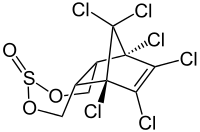Endosulfan
 |
|
 |
|
| Names | |
|---|---|
|
IUPAC name
6,7,8,9,10,10-Hexachloro-1,5,5a,6,9,9a-hexahydro- 6,9-methano-2,4,3-benzodioxathiepine-3-oxide
|
|
| Other names
Benzoepin, Endocel, Parrysulfan, Phaser, Thiodan, Thionex
|
|
| Identifiers | |
|
3D model (Jmol)
|
|
| ChEBI | |
| ChemSpider | |
| ECHA InfoCard | 100.003.709 |
| KEGG | |
| UNII | |
|
|
|
|
| Properties | |
| C9H6Cl6O3S | |
| Molar mass | 406.90 g·mol−1 |
| Appearance | Brown crystals |
| Odor | slight sulfur dioxide odor |
| Density | 1.745 g/cm3 |
| Melting point | 70 to 100 °C (158 to 212 °F; 343 to 373 K) |
| Boiling point | decomposes |
| 0.33 mg/L | |
| Vapor pressure | 0.00001 mmHg (25 °C) |
| Hazards | |
| Main hazards | T, Xi, N |
|
EU classification (DSD)
|
Yes (T, Xi, N) |
| R-phrases | R24/25 R36 R50/53 |
| NFPA 704 | |
| Flash point | noncombustible |
| US health exposure limits (NIOSH): | |
|
PEL (Permissible)
|
none |
|
REL (Recommended)
|
TWA 0.1 mg/m3 [skin] |
|
IDLH (Immediate danger)
|
N.D. |
|
Except where otherwise noted, data are given for materials in their standard state (at 25 °C [77 °F], 100 kPa).
|
|
|
|
|
| Infobox references | |
Endosulfan is an off-patent organochlorine insecticide and acaricide that is being phased out globally. The two isomers, endo and exo, are known popularly as I and II. Endosulfan sulfate is a product of oxidation containing one extra O atom attached to the S atom. Endosulfan became a highly controversial agrichemical due to its acute toxicity, potential for bioaccumulation, and role as an endocrine disruptor. Because of its threats to human health and the environment, a global ban on the manufacture and use of endosulfan was negotiated under the in April 2011. The ban has taken effect in mid-2012, with certain uses exempted for five additional years. More than 80 countries, including the European Union, Australia, New Zealand, several West African nations, the United States, Brazil, and Canada had already banned it or announced phase-outs by the time the Stockholm Convention ban was agreed upon. It is still used extensively in India, China, and few other countries. It is produced by Makhteshim Agan and several manufacturers in India and China.
Endosulfan has been used in agriculture around the world to control insect pests including whiteflies, aphids, leafhoppers, Colorado potato beetles and cabbage worms. Due to its unique mode of action, it is useful in resistance management; however, as it is not specific, it can negatively impact populations of beneficial insects. It is, however, considered to be moderately toxic to honey bees, and it is less toxic to bees than organophosphate insecticides.
The World Health Organization estimated worldwide annual production to be about 9,000 metric tonnes (t) in the early 1980s. From 1980 to 1989, worldwide consumption averaged 10,500 tonnes per year, and for the 1990s use increased to 12,800 tonnes per year.
...
Wikipedia

